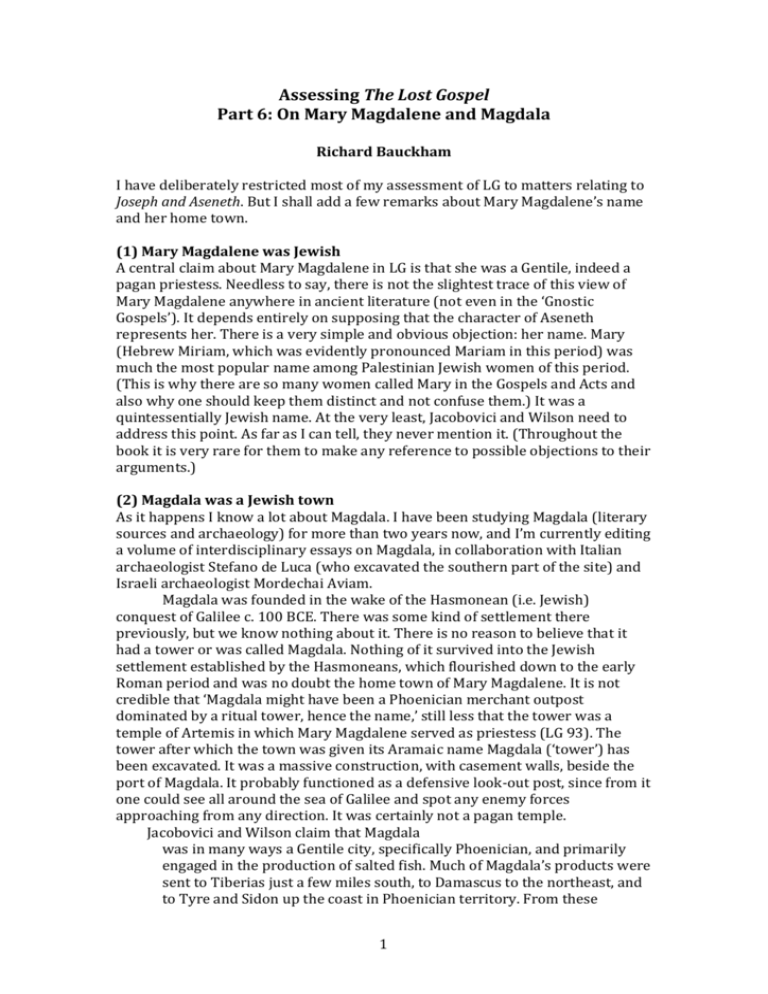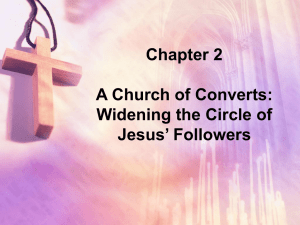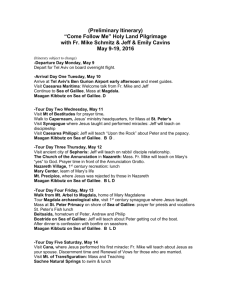Assessing The Lost Gospel Part 6: On Mary
advertisement

Assessing The Lost Gospel Part 6: On Mary Magdalene and Magdala Richard Bauckham I have deliberately restricted most of my assessment of LG to matters relating to Joseph and Aseneth. But I shall add a few remarks about Mary Magdalene’s name and her home town. (1) Mary Magdalene was Jewish A central claim about Mary Magdalene in LG is that she was a Gentile, indeed a pagan priestess. Needless to say, there is not the slightest trace of this view of Mary Magdalene anywhere in ancient literature (not even in the ‘Gnostic Gospels’). It depends entirely on supposing that the character of Aseneth represents her. There is a very simple and obvious objection: her name. Mary (Hebrew Miriam, which was evidently pronounced Mariam in this period) was much the most popular name among Palestinian Jewish women of this period. (This is why there are so many women called Mary in the Gospels and Acts and also why one should keep them distinct and not confuse them.) It was a quintessentially Jewish name. At the very least, Jacobovici and Wilson need to address this point. As far as I can tell, they never mention it. (Throughout the book it is very rare for them to make any reference to possible objections to their arguments.) (2) Magdala was a Jewish town As it happens I know a lot about Magdala. I have been studying Magdala (literary sources and archaeology) for more than two years now, and I’m currently editing a volume of interdisciplinary essays on Magdala, in collaboration with Italian archaeologist Stefano de Luca (who excavated the southern part of the site) and Israeli archaeologist Mordechai Aviam. Magdala was founded in the wake of the Hasmonean (i.e. Jewish) conquest of Galilee c. 100 BCE. There was some kind of settlement there previously, but we know nothing about it. There is no reason to believe that it had a tower or was called Magdala. Nothing of it survived into the Jewish settlement established by the Hasmoneans, which flourished down to the early Roman period and was no doubt the home town of Mary Magdalene. It is not credible that ‘Magdala might have been a Phoenician merchant outpost dominated by a ritual tower, hence the name,’ still less that the tower was a temple of Artemis in which Mary Magdalene served as priestess (LG 93). The tower after which the town was given its Aramaic name Magdala (‘tower’) has been excavated. It was a massive construction, with casement walls, beside the port of Magdala. It probably functioned as a defensive look-out post, since from it one could see all around the sea of Galilee and spot any enemy forces approaching from any direction. It was certainly not a pagan temple. Jacobovici and Wilson claim that Magdala was in many ways a Gentile city, specifically Phoenician, and primarily engaged in the production of salted fish. Much of Magdala’s products were sent to Tiberias just a few miles south, to Damascus to the northeast, and to Tyre and Sidon up the coast in Phoenician territory. From these 1 commercial hubs and Mediterranean port cities, Magdala’s salted fish would have made their way throughout the empire. As a result of this, many of Magdala’s inhabitants were Gentiles. The proof is in the material culture found in Magdala and in Bethsaida, a related Galilean town engaged in the fishing industry. Specifically, the archaeology reveals coins, statues, altars, and so forth, that attest to the fact that the residents of these towns were both Jewish and Gentile. Magdala also had many links to Phoenicia just a few miles north to the northwest, outside Jewish territory (LG 206-7). A good deal of this is imagination and much is wrong. It is certainly true that Magdala flourished because of its fishing industry: both catching the fish and processing it to produce salted fish (the only form in which fish could be transported more than a few miles) and fish sauce, the famous garum that was extraordinarily popular throughout the Roman world. These fish products were certainly exported, but we do not actually know to where. In the Mediterranean world they would have been in competition with the flourishing trade in fish products from Spain, North Africa and the Black Sea region. The most obvious major markets for Magdala would have been Sepphoris (in Galilee), Tiberias (only after 18 CE, when it was founded), Jerusalem, the Golan and the Decapolis cities across the lake. Magdalene fish products may have travelled further afield, but Phoenicia (Tyre and Sidon) is actually not a very likely destination, because Phoenicia had its own fish processing industry. I know of absolutely no evidence that ‘Magdala also had many links to Phoenicia.’ Magdala (in Galilee) and Bethsaida (not a Hasmonean foundation) (strictly speaking, not in Galilee, but in the Golan) had very different histories and should not be assimilated when discussing their cultures. There are no statues or altars from Magdala – or indeed from anywhere in Galilee. Coins prove nothing relevant here: they are found everywhere and were used by everyone. (Tyrian coins depicting Phoenician gods were even the official currency of the Jerusalem Temple.) What we can say, at least about the southern part of the city of Magdala, the area around the port and including a palaestra and a large complex of Roman baths, is that it was significantly romanized in its culture, but this is not evidence of the ethnicity of the inhabitants. Nor does it prove that the inhabitants were not observant Jews, for Jews in many parts of the Roman world were quite prepared to adopt aspects of the common culture that did not involve them in honouring pagan gods. What we do not find in Magdala – or anywhere in Galilee in the period following the Hasmonean conquest – is any evidence of pagan religion: no temples, no altars, no statues. All we have in the way of figurative art from Magdala is a mosaic in the baths decorated with the standard motifs used in such a context: a dolphin, a ship, implements used in the baths and athletics. It is likely enough that a few Gentiles lived in Magdala – merchants, perhaps, and other people brought there by Magdala’s trade – but there is no basis for supposing that ‘many of Magdala’s inhabitants were Gentiles.’ When Josephus the Jewish historian made Magdala (he calls it by its Greek name – Tarichaeae, meaning ‘fish factories’) his headquarters during the Jewish revolt in the late 60s, it seems from his accounts to have been an entirely Jewish town, where Gentiles were not welcome. The total absence of Gentiles at that time may have been the result of the revolt, which would have made Gentiles feel unsafe 2 and unwelcome, but, on the other hand, Tarichaeae in Josephus’ time does not sound like a town from which a large proportion of its inhabitants (Gentiles) had fled, to be replaced by new Jewish inhabitants. That Magdala was ever anything but a dominantly Jewish settlement there is no reason at all to suppose. 3







